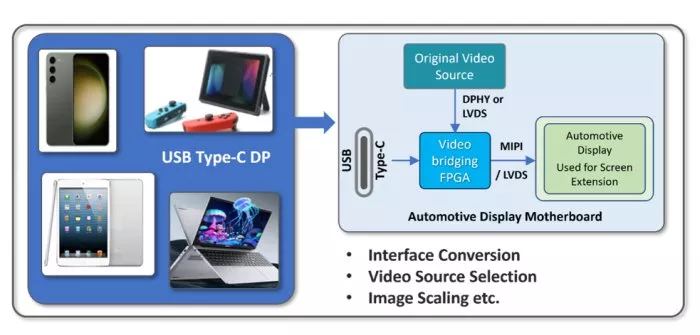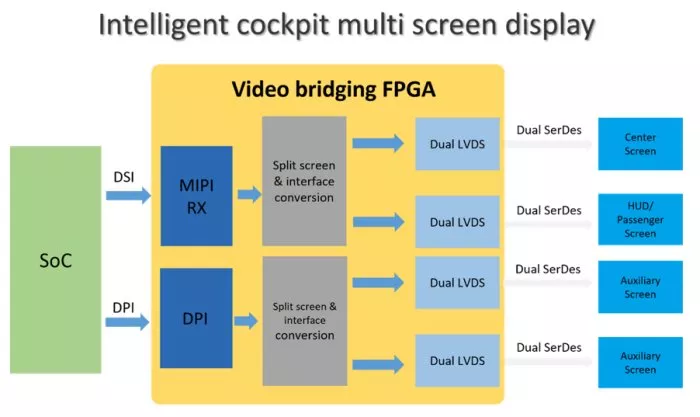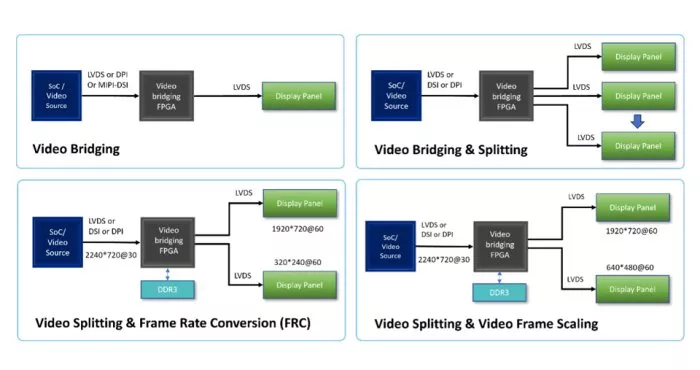Why Transceiver-Rich FPGAs Are Suitable for Vehicle Infotainment System Designs
By Danny Fisher, director of International Marketing, GOWIN Semiconductor
With the global transition in the automotive industry from the internal combustion engine (ICE) to electric drivetrains well under way, the basis of competition in this market is undergoing a paradigm shift. In the old automotive world, the drivetrain was the primary factor that distinguished one segment from another: Consumers understood the differences in cost and appeal between, for instance, a compact car with a 1-liter petrol engine, a family sedan with a two-liter diesel engine and a high-performance model with a four-liter turbocharged petrol engine.
By contrast, there is no such hierarchy of electric drivetrains. Instead, the focus of competition in the electric vehicle (EV) market is more on other factors than on the drivetrain: styling, driving range, and, crucially, the in-cabin experience.
It turns out that, given the choice, car buyers want the information, entertainment, user interface, audio and display features of the car to mirror those of the devices that they use outside the car, and especially the smartphone.
This move to a design philosophy, in which the car is treated as a smartphone on wheels, is powerfully symbolized by the launch in 2024 by Xiaomi, a globally renowned manufacturer of smartphones and consumer devices, of its first car, the SU7. In a smartphone, however, rendering of video content and the user interface is limited to the area available in a single, small display screen; in a car, there is scope to show information and entertainment content on multiple display screens in various sizes, formats and resolutions.
This makes display provision and performance one of the most important new battlegrounds over which car manufacturers will be fighting. And this is fueling demand for a new generation of video bridging and processing components that will enable the shift to a more consumer device-like interior in the car.
The implications of new smartphone-based system architectures in the car
In the new EV market, the functions that the car is asked to perform (beyond the basic act of mobility) are increasingly similar to those of a smartphone, including:
- Communication with people and things
- Provision of audio and video entertainment
- Navigation
- Internet search and other forms of information provision
- Work-related functions, including the use of productivity apps such as spreadsheets and documents
Car manufacturers are finding that the most effective designs for supporting this range of smartphone-like functions are based on smartphone-like hardware: automotive infotainment systems increasingly use applications processor platforms borrowed from the smartphone world, such as Qualcomm Snapdragon products or MediaTek 86xx family SoCs. These SoCs readily support the implementation of smartphone emulation products such as the Apple AirPlay or Android Auto software companions.
But the architecture of these Qualcomm, MediaTek and similar smartphone SoCs does not map perfectly on to the hardware configuration of the new type of car cabin design. The SoCs’ display output is optimized for a single, small display screen: This output is generally an HD signal carried over a MIPI DSI or an embedded DisplayPort (eDP) interface.
With strong competition in the EV market driving waves of innovation in cabin design, manufacturers are packing more and bigger displays into the interior, including:
- A large center console display, sometimes running across the entire width of the dashboard
- A digitally rendered virtual instrument cluster
- A holographic heads-up display in front of the driver
- 4K displays in the rear of the headrests on each of the front seats
- A large 4K roof-mounted central display for passengers in the rear seats
These displays feature a variety of specifications for resolution and refresh rate and are of various sizes and aspect ratios. A smartphone SoC with just a DSI and an eDP interface cannot meet the requirements of the four or more different displays in the cabin of the latest EV designs.
This calls for new solutions to bridge the SoC’s output to multiple displays’ inputs.
The engineering challenge is complicated even further by consumers’ desire to use inside the car content and apps that are on their other devices. This is reflected in the move to upgrade the USB ports provided in the front and rear of the car from the USB 2 specification to USB 3 grade, and in the latest USB Type-C connector format. In particular, this allows passengers in the rear seats to cast 4K content from a tablet, laptop computer or smartphone to a large roof-mounted rear center display via a DisplayPort-over-USB Type-C interface. It can also enable display extension for a laptop computer to enhance the cabin’s value as a workspace for a rear passenger. At the same time, the rear center display still needs to provide an interface to the car’s own infotainment SoC as the default content source when no USB Type-C device is connected (see Figure 1).

Fig. 1: the rear roof-mounted display can take inputs separately from a USB Type-C device or from the car’s infotainment SoC
This increase in the number, size and quality of displays inside the car’s cabin marks a profound shift in interior design philosophy, from the car as a mobility product to the car as an entertainment hub and workspace.
This is a new philosophy forged in response to fast-moving shifts in consumer tastes and preferences. Car makers will continue to learn over time what appeals to car buyers, and to evolve their designs for the user interface in response to customers’ changing tastes.
So car manufacturers need a way to meet the need to bridge from the limited display outputs of a smartphone SoC to the multiple display input requirements of the car, while also providing high-speed USB 3, LVDS and MIPI D-PHY or C-PHY signaling rates. At the same time, they need to maintain the ability to respond rapidly to changes in consumer demand, and to iterate designs repeatedly with the least possible hardware development effort.
An expanded role for FPGAs in new designs for the car’s UI
As telecoms equipment and server manufacturers know, FPGAs can implement very high-speed interfaces operating at high signaling rates. In networking equipment, FPGAs are widely used to provide interfaces that conform to the latest specifications of standards such as PCIe or Ethernet.
Because an FPGA is a programmable device, it offers the flexibility to modify designs rapidly in response to changing design specifications without requiring a change to the board design. This is a valuable benefit in today’s EV market, in which product development cycles are dramatically shorter than was the case when the integration and assembly of complex, difficult petrol- or diesel-fueled drivetrains set a slower pace for the entire new product development process.
The approach to developing new EV models is becoming more like that for developing new smartphone products: fast, and with innovation in display, camera and video technologies to the fore. This calls for automotive-qualified FPGA products that can meet the requirement for a growing range of video bridging and image processing functions.
Today, the Chinese EV industry is widely acknowledged to be setting the pace for the rest of the world in car UI design. Design innovations and technology solutions developed for EVs in China are expected to find their way into new car designs under development elsewhere in east Asia, as well as in Europe and the US.
This means that FPGA manufacturers that have a strong position in the Chinese automotive market are exposed to the cutting edge in EV design, and so are often the first to respond with FPGA product developments that meet the need for new and improved display interfacing and image processing capabilities which bridge between a smartphone SoC and a car’s infotainment system.

Fig. 2: smartphone SoCs with limited output capability can use a specialist FPGA for bridging to multiple display screens
This explains why the market is seeing the introduction of a new generation of automotive-grade FPGA products which fit EVs’ emerging application requirements, including:
Multi-screen display outputs with signal translation over long cable runs. A single infotainment SoC derived from a smartphone platform typically produces limited video outputs. In new display-rich car interiors, this output needs to be bridged to displays in both the front and rear of the cabin, while potentially converting the signal to MIPI or LVDS format (see Figure 2).
Screen extension – outputs from a tablet or laptop computer’s USB Type-C interface need to be converted to a MIPI or LVDS format that a large automotive display can handle (see Figure 1). When no external video source is connected, the default SoC’s video source is automatically supplied to these screens. This calls for a combination of logic functions (for source selection), bridging (for instance from MIPI D-PHY to LVDS) and video processing (for instance for display image scaling).
Video bridging, splitting and frame-rate conversion (see Figure 3).

Fig. 3: typical examples of the video processing applications required in new infotainment system designs based on smartphone SoC platforms
The availability of these new high-speed, programmable image processing devices will enable automotive manufacturers everywhere to respond more quickly and flexibly to the dynamics of the car market in which consumers who no longer obsess about horsepower are starting to demand an interior design with more entertainment, information and productivity features – and more and bigger displays.
Related Semiconductor IP
- NPU IP Core for Mobile
- NPU IP Core for Edge
- Specialized Video Processing NPU IP
- HYPERBUS™ Memory Controller
- AV1 Video Encoder IP
Related White Papers
- Why Transceiver-Rich FPGAs Are Suitable for Vehicle Infotainment System Designs
- Why advanced DSPs running RTOSs are an ideal match for the IoT
- FPGA based Complex System Designs: Methodology and Techniques
- How to use FPGAs to develop an intelligent solar tracking system
Latest White Papers
- Ramping Up Open-Source RISC-V Cores: Assessing the Energy Efficiency of Superscalar, Out-of-Order Execution
- Transition Fixes in 3nm Multi-Voltage SoC Design
- CXL Topology-Aware and Expander-Driven Prefetching: Unlocking SSD Performance
- Breaking the Memory Bandwidth Boundary. GDDR7 IP Design Challenges & Solutions
- Automating NoC Design to Tackle Rising SoC Complexity